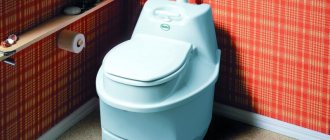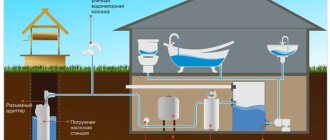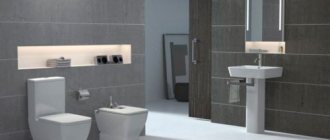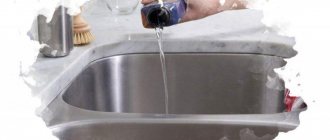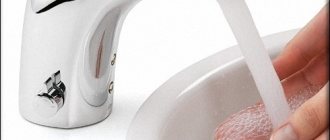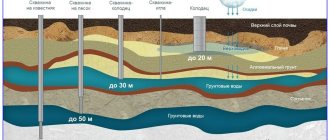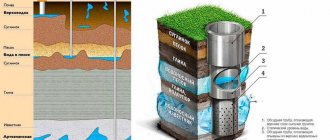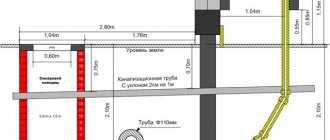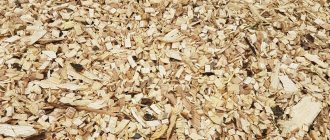Without water, not a single piece of land can be called fertile and suitable for human exploitation. That is why a well has become such a popular source of water in the modern world, which can be easily installed almost anywhere on the site. In this article we will tell you about the ease of using a pump located directly in a residential building.
A small investment will allow you to provide water not only for your home, but also for all your needs on the site
Drainage in a private house
Water supply diagram in a private house
For the full functioning of the home water supply system, a sewer pipeline should be installed in a country house or cottage. The cross-section of the pipeline depends on the total volume of discharged wastewater. But for domestic sewerage, tubes with a diameter of 150-200 mm are often used.
The main requirement of SNiP is that pipes are laid with a mandatory slope towards the cesspool or septic tank. This eliminates system malfunction. According to the standards, the slope varies depending on the cross-section of the pipes. For a diameter of 200 mm, the level is 0.8 cm per linear meter of line. As the cross-section of the sewer system decreases, the slope level increases.
The drainage system is also installed below the ground freezing level
If this cannot be done due to the peculiarities of the terrain on the site, it is important to provide high-quality insulation of the main line. It is not advisable to install/install sewerage along the top of the street.
Otherwise, the system will constantly freeze. Or with this installation method, high-quality insulation is used.
By law, it is prohibited to install open (unsealed) cesspools in the yard. This leads to an environmental disaster and pollution of the village’s groundwater. As a wastewater receiver, it is better to build a homemade septic tank with 2-3 chambers and discharge waste into it. Many consumers/craftsmen prefer to install a factory cleaning tank. This is a plastic container with stiffening ribs. The places where the collector is supplied to the tank are reliably sealed to avoid leakage of wastewater into the ground. A sealed septic tank does not allow specific odors to pass through and efficiently cleans wastewater before it is discharged into the ground.
Well for limestone (artesian)
Advantages
Artesian wells are the most expensive, but for a number of reasons they are considered the most practical solution to the problem of water supply for a private country house or cottage:
- High productivity more than meets the water supply needs of one or two households
- Long service life (30 years or more)
- The aquifer is less susceptible to technogenic pollution
- Possibility of using efficient and reliable pumping equipment
- Warranty up to 10 years
The hydrogiology of the Moscow region is such that aquiferous limestones are located at any point at an accessible depth.
Flaws
According to experts, the disadvantages include three factors:
- Relatively high cost
- The chemical composition of water in most cases does not meet the requirements of sanitary Standards and Rules for drinking water
- Legislative gap in registration of wells by individuals
The depths of aquiferous limestones in the Moscow region vary widely. In the southern regions of the Moscow region, limestones can come to the surface (on the banks of the Protva and Oka), and in the northern regions they can lie at a depth of 200 meters (Khotkovo, Sergiev Posad district).
On the website you will find detailed descriptions of geological sections of artesian wells for each district of the Moscow region, but in this article we will limit ourselves to general characteristics.
Even in the examples of the smallest areas of the Lyubertsy and Krasnogorsk districts, a large variation in depths is observed:
| Area | Locality | Well depth for limestone, meter |
| Krasnogorsky | Golyevo | 50 |
| Nikolo-Uryupino | 130 | |
| Lyubertsy | Korenevo | 40 |
| Kotelniki | 100 |
It is common practice for depths within one settlement to differ by 10 meters or more.
We emphasize that there are no exact forecasting methods in hydrogeology. You can only get the most reliable data from your closest neighbors who already have their own well.
Experts will advise you on the expected depths specifically in your locality. Call us.
To better imagine what an artesian well is, watch a video in which a video camera descends to its bottom and records everything around it. You will see a monotonous picture, when the chamber is surrounded by a casing string, only threaded joints flash. You will see a mirror of water. You will see the water intake part in the form of an open trunk with clearly defined cracks, through which water flows during its selection.
What determines the durability and reliability of an artesian well?
The soft rock surrounding the source shaft is kept from collapsing by a casing constructed from casing pipes. Until recently, steel pipes were used as casing. The best quality when assembling a casing string from individual pipes is considered to be a threaded connection, which is sold in two versions:
- Pipe to pipe
- Via a coupling threaded connection
Photo 3 shows sections of threaded connections: on the left – pipe into pipe, on the right – through couplings.
The time of through corrosion of the casing largely determines the service life of the source.
From the point of view of durability, the second option is more preferable, since through corrosion will manifest itself first on threaded connections.
In most industries, polymer materials have replaced metal. Innovations have not spared hydrogeology. Solutions made from unplasticized polyvinyl chloride (uPVC) in their strength properties are not inferior to steel ones with one difference: they are not subject to corrosion. The service life of “polymer” wells is longer, more than 50 years. But at aquifer depths of more than 120 meters, these technologies have limitations.
Limestone is considered a hard rock and is not subject to destruction. Sometimes limestone contains layers of sand and clay, as well as layers of destroyed limestone. Then a second casing of smaller diameter, preventing the collapse of soft rocks in the limestone body itself, is necessary. In most cases, products made from low-density polyethylene HDPE, which are not subject to corrosion, are used.
We came to the conclusion that there are different well designs: single-pipe and double-pipe.
Water in a limestone horizon is usually under pressure. Waterproof clays located above and below do not allow it to go beyond these boundaries. Like the surface of the earth, the limestone layer has its own relief and different thicknesses. The same applies to geological rocks located above or below. The aquifer itself can be considered a system of communicating vessels in which, according to the well-known law of physics, the water level is the same. The diagram explains possible differences in depths and water levels, as well as differences in well designs. Bold lines indicate the main casing, made of steel or polymer (uPVC) pipes.
There are two more rules:
- The pump is installed in a well below the water level, and a decrease in the level while the pump is running should not expose the pump
- The pump must not be installed in an open shaft.
Let's comment on each option from left to right:
- Self-discharge well. Provided that the limestone does not have soft layers, you can limit yourself to a single-pipe design. In the Moscow region, the described variant is extremely rare (in the Naro-Fominsk, Taldom and Dmitrov regions)
- A submersible pump is installed in the well. If the limestone is strong and clean, a single-pipe design is possible. But such a successful combination of levels and geology is rare.
- The water level rises above the limestone roof to an insufficient height to install the pump. The limestone trunk is lined with a plastic pipe. The most common option.
- The only difference from the previous one is that the water does not rise above the limestone roof. Occurs in 30% of cases.
It is allowed not to bring the polymer pipe to the surface provided that a packer (special sealing structure) is used.
The most common water well designs are summarized in the table:
| External casing | Steel with a diameter of 133 mm or 159 mm, | Steel with a diameter of 133 mm or 159 mm, | Steel with a diameter of 133 mm or 159 mm, | uPVC with a diameter of 170 and/or 140 mm |
| Connection method | Pipe to pipe | Pipe to pipe | Coupling | Pipe to pipe with socket |
| Internal casing | Open trunk | HDPE with a diameter of 117 mm or 125 mm | HDPE with a diameter of 117 mm or 125 mm | uPVC with a diameter of 125 mm or HDPE with a diameter of 117 mm |
As we understand, the time of its through corrosion depends on the wall thickness of a steel pipe, and for a polymer analogue, its strength characteristics.
Minimum wall thicknesses of casing pipes to ensure the required quality:
| Material | Steel | HDPE | uPVC |
| Diameter, mm | 133, 159, 168 | 117, 125 | 125, 140, 170 |
| Wall thickness, mm | 4,5 | 7,0 | 7,0 |
It's not difficult to check. Meet the team with a caliper.
Warning: reducing the thickness of the pipe walls is unacceptable!
What to avoid
- A number of drilling companies, in an effort to reduce their own costs, are resorting to the use of thin-walled alternatives. They call their solutions “breakthrough” and the pipes “reinforced”. A threaded end made of regular pipe is butt welded to a thin-walled pipe. The result is that the thin-walled part will rot faster, and unnecessary welding joints cannot strengthen the structure in any way.
- Metal-plastic pipes do not solve the problem of protection against corrosion of threaded connections. For the increased price you do not get the quality you need.
- Some use thin-walled pipes, connecting them into a column by welding. The dependence on the human factor is huge! Often, the casing is initially leaking.
- Using recycled polyethylene solutions. You and I do not wrap food in garbage bags, which are made specifically from recycled polyethylene.
Well guarantee
The duration of the warranty depends on the design of the source and the quality of the materials used. Since the performance of the well itself is affected by pumping equipment, separation is practiced:
5 year warranty
Provided for a structure using steel pipes connected using pipe-to-pipe threads, drilled and equipped.
10 year warranty
Provided for a structure using uPVC pipes or steel analogues with a coupling connection, drilled and equipped.
If the Customer carries out the installation on his own, the warranty period is reduced: in the first option to 3 years, in the second - up to 5 years.
Drilling methods
Artesian wells are drilled using the rotary method with direct flushing. URB 2A-2 drilling rigs have been successfully coping with these tasks for several decades. In most cases, the drilling rig is located on the basis of a three-axle all-terrain vehicle Ural, Zil 131 or Kamaz (photo 4). For obvious reasons, to place such a truck on the site, an area of 9 by 4 meters is required.
If the work site has a limited area (equipped or small area), then it is possible to use small-sized installations “Crane” or “KZBT” (photo 5).
Wellbore formation
The process of manual percussion-rope drilling
In order to freely bring water into the house from a well, you must first reach the aquifer yourself or with the help of professionals. For this, the following drilling methods are used:
- Auger. It involves a gradual deepening around its axis of the installation with rounded blades and excavation of the soil upward. Used to drill a shaft in soft sandy-clayey soils.
- Shock-rope. Here a heavy steel sleeve with sharp serrated edges and a closing flap is used. The glass is sharply lowered into the ground from a height of 0.5-1 m. Thus, it captures part of the soil into its flask and lifts it up. The sleeve flap prevents soil from spilling out.
- Rotary drilling with parallel supply of water into the mine for its flushing.
For independent percussion-rope drilling, it is advisable to mount the winch on a tripod. It will automatically lift the mass of the driving glass with soil to the top.
Necessary equipment
Having decided on the type of system, drawn up a diagram and carried out calculations, we begin to select equipment. Of course, if the work is carried out by a specialized organization, the design documentation indicates the type, performance and brand of equipment.
However, often the site owner purchases components from different manufacturers, focusing on reviews and quality. Despite this, the pump is especially important - the performance of the entire system and the supply of water depend on it.
In this case, it is really worth paying attention to the reputation of the manufacturer, whose product quality has been tested by time. Otherwise, if you decide to save money, the risk of breakdown increases.
The main pump is mounted in the well itself. Its task is to maintain stable pressure along the entire line. Also, 1-2 pumps with lower capacity can be additionally installed in the system , the purpose of which is to ensure the operation of certain equipment.
As for performance indicators, the pump is purchased taking into account 10-15% less than the volume of liquid that the well produces per unit of time. This will avoid dry running and quick repairs. The remaining elements of the system can be selected based on the price-quality ratio.
Water quality
The difference between a well and a borehole is quite large. It's all about the aquifers, which are located at different depths. The well, drilled into sand up to 50 m, meets all sanitary control standards.
But only analysis in the laboratory will help you more accurately determine the suitability of the source. The flow rate of the installation depends on the correct drilling and installation of the casing pipe. Another important factor in the constant presence of liquid is the aquifer itself.
Artesian wells provide a cleaner and more reliable water resource. Due to the passage of liquid through several layers of soil and clay, it is purified and filtered. Often the flow rate of the source is so strong that it comes from the depths to the surface. Getting into such a vein is a great success for the owners of the land plot.
A key well can dry up at any moment or last for decades. As for water quality, it is relatively high. The pressure that forces fluid to move from the subsurface to the surface, pushing it through multiple rocks of the soil, purifying it.
In a mine well, the water still needs to be reached and its quality leaves much to be desired. In this case, you need to know exactly where to start excavation work. Often it is unsuitable for drinking and cooking. In a garden plot or country house it can be used for watering or animals.
The Abyssinian spring is deeper than the mine one, which means the water in it is cleaner. The core well is not in danger of silting. The aquifer through which the pipe passes lies at a depth of up to 40 m. The source is recharged through the upper and lower sand layers. An artesian located nearby has a positive effect on the flow rate of the well.
Well: the most famous source of water supply
A well is a shallow shaft for drawing water from a perch or sand lens. Depth – up to 30-40 meters. Reinforced concrete rings are used to strengthen the walls. It is protected from debris, rain, and melt water with a lid. A clay castle is being built within a radius of 0.6 m. Water supply - using a submersible pump, pumping station or manual mechanical method.
Benefits of the well:
- low cost;
- simple design.
Disadvantages of an autonomous source:
- productivity is seasonal (unstable flow rate during dry periods);
- periodic drying of the well;
- during floods the water is unsuitable for drinking;
- high risk of contamination;
- Regular cleaning is required;
- Water requires boiling before use.
Wells are used for watering plants in a small garden plot.
Selecting a well type
The presence of water in the house is the main component of a person’s comfortable existence.
To organize the water supply system for a cottage, including a bathhouse, a swimming pool, all plumbing points in the house use a sandy or artesian source.
The first has a depth of 15 to 40 meters, depending on the terrain and the location of the aquifer. Before drilling a sandy hydraulic structure, it is advisable to conduct reconnaissance hydrogeological surveys. The advantages of such a well:
- service life - 10-15 years;
- good quality water that can be drunk immediately; often you don’t even have to install complex filter systems for iron removal or reverse osmosis;
- the possibility of drilling with your own hands, the process will take from 2 to 5 days;
- productivity - 0.5-1.5 m3/hour;
- minimal siltation of the source, provided it is located in coarse sand.
The structure of an artesian well and a sand well
A sand well can be freely preserved for the winter, if necessary.
The artesian spring has a depth of 50 to 200 meters. The level of occurrence of the aquifer depends on the volume of the resource in the floodplain of the river in a particular region. The well has a high productivity of 2-5 m3/hour. This allows you to supply water to several large cottages or even a small village at the same time. Drilling of an artesian source is carried out only using sophisticated equipment. In addition, a well of this type requires a license/permit. Artesian spring resources are taxed. The service life of a well is about 50 years.
Choosing a drilling site
The well must be located so that distances are maintained to guarantee its protection from contamination.
Before installing a water supply from a well in a private house with your own hands, it is important to determine the location of the source. It must meet the following criteria:
The distance from a residential building is at least 5 meters. The distance between the well and the point of discharge of sewage waste should be maximum, but not less than 15-20 meters. It is important to maintain the possibility of free access to the source. It may be needed during repairs or maintenance. You can determine the drilling location (the expected location of the aquifer) with the help of professionals or by external signs
The proximity of an underground vein is indicated by:
You can determine the drilling location (the expected location of the aquifer) with the help of professionals or by external signs. The proximity of an underground vein is indicated by:
- lush vegetation, characterized by richness even in the heat;
- abundance of midges in the desired area in the evening;
- dogs' love of the aquifer location on hot days;
- thick billowing fog in the morning over the aquifer.
Caisson or adapter?
The adapter is cheaper than a caisson, and its installation is relatively simple. However, this simplicity makes well maintenance inconvenient. If it is necessary to prevent or repair the adapter, you will have to dig up the soil around the tip again. The adapter is not installed on wells with a pump lowering depth of more than 70 m. The material from which the adapter parts are made (copper, brass) may not withstand the total weight of the equipment. Water-lifting equipment is installed in the house.
steel caisson for well
A steel sealed caisson is more expensive than an adapter and will require more extensive excavation. In the caisson, the well and water-lifting equipment will be maximally protected from all negative external manifestations. Access to the equipment at any time of the year takes a minimum of time - you just need to open the hatch cover
What is included in drilling a well for drinking water in a private home:
- drafting;
- pit drilling;
- installation and connection of equipment;
- settling tank equipment;
- pipeline laying;
- installation of filter systems;
- installation of plumbing equipment.
The price of a well on a plot of land in a house depends on:
- pit depths;
- method of water intake;
- distances for laying water pipes;
- internal wiring and plumbing connections.
Comparison of well and borehole
In a private or country house, problems with water supply often arise. Typically, owners equip an autonomous source. As a rule, a well or borehole option is chosen.
A number of criteria are used to compare the pros and cons. First, the difficulty of finding the water layer is taken into account. From this point of view, the construction of a well is very difficult, because it requires thorough drilling. And for a well, due to its shallow depth, the procedure will not cause problems.
When choosing a source for water, you need to take into account the level of its pollution
For residents, water quality comes first. In a well source, the liquid is protected by a large layer of soil. In a well, contamination can easily get into the source due to its shallow depth.
When installing a well, professional equipment is used, which simplifies the process. But for a well, most of the work is done manually. But when connecting communications there are more difficulties - when arranging the well option.
The amount of liquid in the well is greater than in the well. And this does not depend on the season, which is often observed at wells. The quality of the fluid itself from a well source is quite high, but the fluid may contain impurities. The problem is resolved using a filter. The quality of water in the well is getting worse and worse every year.
The longevity of a well source can be measured in decades. At the same time, installations rarely require maintenance. The well is also durable, but requires periodic cleaning. A higher cost is observed when constructing a well.
This is interesting: Abyssinian water wells
Disadvantages of a well
In order to obtain high-quality water without impurities, when drilling it is necessary to use professional, expensive equipment
. Along with obvious advantages, the well has some negative aspects:
- The need for a powerful submersible pump, which has a fairly high cost.
- Dependence of supply on the availability of electricity. It is impossible to draw water from a well manually, so in case of a power outage you have to look for alternative sources.
- High cost of drilling deep wells. To obtain high-quality artesian water, deep drilling is necessary, which is only possible if special equipment is used. The cost of such work is relatively high.
- The need to obtain permits for the construction of a deep artesian well.
Sometimes a deep well is the only way to provide a country house with water. Despite the material costs, the structure is being built for many years and is well worth the money invested in it.
Water supply to a private house from a well; system diagram for a private house
In order to draw up a diagram for the supply of drinking or technical water to your country house, you must first decide on the schedule for its operation. If the building is intended to be used seasonally, then installing a water supply system from a well will be the best option to meet household needs. For permanent residence, taking into account the volume of daily water consumption, it is recommended from a well.
What factors to consider when developing a water well installation plan?
Selecting a water consumption plan begins with conducting geological studies of the site and determining the type of water intake source. Wells and wells may differ somewhat from each other in their structure and method of construction. The degree of their difference depends on the boundary of the aquifer.
Based on the nature of their location and hydraulic characteristics, resources are divided into several types:
Wells and wells differ in structure.
- perched water;
- ground;
- interlayer (filter);
- artesian (pressure).
Verkhodka, as well as layers with groundwater, are located close to the surface and are not reliable, since their reserves depend on the volume of precipitation.
Filter and artesian springs are located at great depths, have a powerful aquifer layer that is independent of weather conditions, have a constant temperature and are protected from pollution.
Taking into account the characteristics of the workings, we carry out test drilling on the site. After this, we determine the location of the water intake point, the depth of the mine, and the method of supplying the resource. Based on the data obtained, we select equipment, the type and completeness of which depends on the following factors:
- In what way is it planned to extract the resource (with a deep-well pump or will a pumping station with automation and a hydraulic accumulator be used).
- The length of the route from the source to the point where water enters the building.
- Number of water devices in a private house.
- Required amount of resource.
The information obtained will allow you to competently and professionally draw up a water supply project for the building, taking into account permanent residence.
Advantages and disadvantages of a typical water supply scheme for a private house from a well
from underground workings, in comparison with the central supply system, has a number of advantages:
- Ensuring the household needs of the house without the participation of the city water utility.
- No monthly subscription fee.
- The pressure and quality of drinking water depend only on the material capabilities of the user.
- The volume of the resource is regulated by the owner of the house based on the amount of installed equipment.
Water supply to the dacha from underground workings.
Flaws:
- The depth of aquifers depends on regional conditions.
- If an artesian well is used, then the price of the finished output is high.
- The need to install additional devices (pump, automation, caisson, etc.).
- If the horizon is weak, there is a possibility of silting of the channel.
Features of a water supply tower scheme in a private house from a well
The tower supply method involves installing an additional tank at the top of the building. To adjust the filling level of the container, the tank is equipped with a float valve.
A submersible pump pumps water through an open valve into the expansion chamber. In this case, the float gradually rises under the influence of the liquid, dragging the mechanism flap along with it, and upon reaching the maximum planned threshold, it shuts off the flow.
Diagram of a water well in a private house with a pump and two-stage supply
Device diagram.
With a two-stage method of supplying resources to the system, an additional pump is installed behind the storage tank, and a hydraulic accumulator is placed behind it. This method allows you to stabilize the pressure in the main line even at low power of the supply station.
After filling the expansion tank, water from the container flows by gravity into the pump chamber, which pumps it into the membrane cavity of the unit. The diaphragm of the device at the right moment pushes the liquid further along the line, thereby maintaining the required pressure force at all flow points.
What to consider when drilling in a house?
If you decide that installing and drilling a well for water indoors is your option, then experts recommend taking into account several important points when carrying out the work:
- It is best to drill a source for water at the stage of building a house and laying the foundation. It will be great if the well is marked on the design documentation and enough space is allocated for it.
- You should not place living rooms, such as a bedroom, living room, or children's room, above a room with a well. The noise from a working station will disturb, and possible dampness will ruin the entire repair.
- It is possible and necessary to drill a well for water at some distance from the foundation. It is advisable to move the well away from the base by at least 1 meter. And even more.
- It is better to build the foundation and the rest of the structure 1-2 months after drilling. And it is advisable to intensively exploit the water source during this time in order to immediately identify all possible shortcomings at the construction stage and eliminate them.
- Sufficient space can and should be left around the drilled water source for maintenance.
Important: the installation of an artesian well, both indoors and outdoors, requires design documentation, a drilling log and a special permit for the operation of the source from Rostekhnadzor authorities. It is worth remembering that experts are always against installing a source indoors. Drilling a well outside the house, that is, outside, is always easier than carrying out work inside the building.
Difference between well, borehole and column
In addition to wells and various types of wells, in the absence of a centralized water supply, water intake columns are often used, characterized by a relatively simple design, installed in a well or directly on the ground, and represented by a valve, an ejector, water-lifting pipes, as well as a column with a special lever.
Despite sufficient performance and visual appeal, such designs have a number of disadvantages:
- mandatory presence in the water supply network of sufficiently high pressure, which will allow the equipment to function fully;
- the likelihood of water freezing in winter, especially if the pressure in the system is too low;
- risk of groundwater or rainwater ingress, even with an appropriate valve system designed to limit the ingress of third-party liquids.
What equipment is used to construct a well?
Caisson
Here you can repeat almost everything that was said above about pipes. Plastic caissons often burst as a result of compression by soil, and due to the fact that they weigh little, they sometimes “float” (pushed out by groundwater). If the seal is broken, not only groundwater, but also rainwater may come out of the tap. The metal caisson remains intact even with severe deformation.
When choosing, pay attention to the quality of waterproofing of the metal structure. The durability of the caisson depends on it.
Well pump
The standard pump diameter is 4 inches. There are also 3-inch models, but they are more expensive for the same performance and pressure. But many well-known manufacturers simply don’t make them.
When purchasing a pump, you can save on the brand. There is a lot of high-quality pumping equipment from “unpromoted” brands on the market. To understand the market situation, compare prices for pumps with similar characteristics from different manufacturers. And don’t forget to discuss this issue with the contractor in advance.
And finally, the most important point!
Filtration well
A filter well is a well that reaches interstratal waters, which lie at a depth of up to 80 meters. Most often, such wells are equipped for private or commercial use. To make such a well you will need powerful equipment. In some cases, you can assemble it yourself if you have certain skills. In areas with soft soils, auger drilling is used. In other cases, rotary drilling stations are used. They cope well with rocks and hard layers.
Advantages and disadvantages
Among the advantages of such a well are:
- high water quality;
- long service life;
- good debit;
- good water mirror.
Water can come from underground rivers, as well as that which falls with precipitation. At the same time, it is very well filtered, because it passes through several different layers. The service life of such a source can exceed 15 years. In some cases, the water is supplied at such pressure that pumping equipment is not required to lift it. Only superficial is needed. Good wells are ready to produce up to 4 cubic meters of water per hour. There are also negative sides to this solution:
- high costs;
- difficulty of maintenance;
- rust may occur;
- a permit for subsoil development is required;
- Possibly high mineral content.
In most cases, you will have to hire a contractor who would cope with the task of drilling such a water well. It is necessary to obtain some permits from the relevant authorities for drilling to such depth. Water from such a well may have increased mineralization. This manifests itself in severe scale on dishes, as well as salt deposits in human organs. To reduce it, you will need to install a good water filter station, which carries additional costs. Maintaining such a water well is also not an easy task, which requires additional pumping equipment or the use of reagents.
Source in the house - advantages
Drilling a source in the house has many advantages:
- Doesn't freeze. The heat of the room maintains the temperature of the water, so in most cases the wells inside the premises do not freeze, which means there are no additional costs.
- Does not require arrangement of a water supply system. Drilling a well in a house eliminates the need to lay pipes for water supply. At the same time, there is no need to carry out additional insulation and perform a bunch of parallel work.
- Economical. If you install a well in the basement of a house, then now its owners will not have to pay for water.
- Protected from external influences.
The well under the house is filled with water from the aquifer entering it. At the same time, rust from numerous central water supply pipes does not get inside, which means the water quality does not deteriorate.
Before making a well in a household, it is necessary to weigh the pros and cons so that it does not turn out that “the miser pays twice.” By the way, it is more correct and more profitable to drill a well during the construction of a house than to place it in a finished building.
Drilling for individual water supply can help heat a home. These are the latest technologies based on geothermal heating. This design is very productive and low-cost, which is a significant advantage for homeowners.
Today, active work is underway in this area and, perhaps, tomorrow such structures will appear in many houses!
Equipping a well with pumping equipment
Typical diagram of an autonomous water supply from a well
Once the source for a house in the village has been drilled and the casing pipe has been installed, it’s time to start installing the water supply from the well. To supply liquid to the cottage and all other auxiliary premises, you need to use a good pump. It is selected according to the following source parameters:
- total depth;
- water level in the well;
- source performance;
- pressure: the total length of the vertical and horizontal sections of the pipeline from the point of water intake to the farthest plumbing fixture;
- power – a frequency converter will help reduce energy consumption.
One of the types of pumps is used for drinking wells:
- Surface. It supplies water from a depth of up to 8-9 meters. Ideal for springs, also called Abyssinian. They are drilled for high water. But such a structure does not have a large flow rate. More often the productivity is about 0.3 m3/hour.
- Submersible deep. It pumps water from different source levels from 20 to 150 m. It looks like a cylinder that is placed in a casing. The price of a submersible unit is always higher than a surface unit.
Additionally, it is recommended to equip pumping equipment with a hydraulic accumulator. The storage membrane tank maintains stable pressure in the system and eliminates the presence of air in it. In the event of an emergency power outage in the area, the family has a supply of water for 1-3 hours, depending on the volume of the hydraulic accumulator. The optimal tank volume is 50-150 liters for 3-4 people living in a house. Detailed diagram of water supply for a private house from a well with a hydraulic accumulator:
- submersible deep pump;
- well adapter (the device looks like a dovetail);
- hydraulic accumulator;
- check valve;
- pipeline from the tank to the house.
All elements are assembled sequentially into one system using high-quality sealant.
Pump installation
Diagram of the correct location of a submersible pump in a well.
A submersible deep pump is mounted in this way:
- A water supply pipe is attached to the outlet pipe using a fitting. Its length should reach the point where the downhole adapter is located.
- At the same time, the electric cable of the pump and a safety cable are laid on the ground. It is advisable to take not steel, but strong nylon.
- All three elements (cable, pipe, cable) are tightened with clamps in increments of 1 m. Strong tension or sagging of each component of the fastener should be avoided.
- A technical hole is made in the casing below the soil freezing level for the outlet of the well adapter. Its back part is connected to the water intake hose and inserted into the connector. From the outside of the casing, the first part of the adapter is connected to the front part and tightened well.
- A section of pipe is connected to the element, which will lead to the hydraulic accumulator.
Hydraulic tank installation
A visual diagram of connecting a pump and a hydraulic accumulator. The
storage tank is placed in a caisson, connecting it to the water supply pipe. One check valve must be installed at the inlet and outlet of the tank. Their connection prevents the outflow of water from the system.
The step-by-step operating principle of the drive is simple:
- When the reservoir chamber is filled, the membrane partition leads to a change in pressure (its increase).
- At this moment the pump switches off.
- As soon as the taps are opened in the house, the liquid leaves the storage tank and the pressure in it drops.
- When the atmospheric indicator decreases, the pump turns on again, replenishing the water reserves in the tank.
To ensure that the on/off cycles of the injection equipment are normal, the operating pressure indicators are adjusted. To do this, a homemade station needs to be equipped with a pressure gauge with a sensor and a relay. The lower pressure limit is 1.5 atm. Upper - 3.5.
At the outlet from the hydraulic tank, a pipeline is pulled from the caisson to the house.
Types of wells
Before you begin, you need to select the appropriate type of well. Depending on how deep the water layer lies, there are three main types of penetrations :
- Abyssinian well.
- Filter well.
- Artesian well.
Now let’s look at the features of each development. The Abyssinian well is a simplified version of drilling that can be drilled almost anywhere. A significant disadvantage of such a well is the relatively low quality of water. More often it is used for watering or other similar needs. This water is not suitable for human consumption or can only be used after multi-level purification. This is due to the fact that waters lying at shallow depths are fed by sediments and contain harmful impurities.
Regardless of the type of well, the presence of a pump is mandatory Source Abyssinianwell.rf
To prepare an Abyssinian well, which is often called a needle well, driving technology is more often used, which cannot be used for work on other types of penetrations. If you have the necessary equipment and assistants, the work on making such a well can be completed within one day.
Before drilling a well with your own hands, it is recommended to calculate in advance exactly how much water is needed. For example, if you need to provide a house, a bathhouse, or other outbuildings, it is better to opt for a filter well - its flow rate is sufficient, and drilling such a hole is relatively simple. The depth of the water layers in this case is from 20 to 30 meters.
Artesian springs are called the best option - they do not silt, since the water is contained in rock cracks, does not contain harmful impurities, does not require filtration and is completely drinkable. Its only drawback is the depth of the water, which can range from 30 to 100 meters or more. Probably, almost everyone is now thinking about how to drill a well under water with their own hands, given such a significant depth. Unfortunately, no way, this type of well is given here only as an example; it is impossible to get to artesian waters using artisanal methods.
Artesian well Source stroybur33.rf
Pump installation
Before supplying water to the house from the well, the pump is equipped with a check valve. This scheme is designed to prevent water from draining back into the source, and to prevent water hammer, which increases many times over at great depths due to pressure changes. The valve is connected to the line through an American crimp coupling.
The pump is inserted into the well using a cable or synthetic cord, which is attached to the eyes on the housing. An electrical cable is attached to the cord to connect the pump. The pump should not reach the bottom, otherwise it will pull sludge to the top. Before removing the pump from the well (for repair, maintenance, or for winter storage), it is disconnected from the power supply.
Water is supplied to the house through pipes laid in the ground at a depth below the freezing point; the entire route is insulated. The easiest way to make insulation is with a polyurethane foam shell; it’s cheaper to cover the route with a layer of expanded clay, which is waterproofed on top. Water must be brought into the house through the foundation; it is better to turn the pipe to a vertical position smoothly, not at an angle of 90 0 - this approach will reduce the possibility of water hammer occurring.
The pipe from the well is connected to a storage tank, from which water is distributed to water collection points and supplied to other equipment - a boiler, boiler, washing machine, and so on. Before you start using your home water supply, it is checked for functionality and tightness.
In the scheme, when the pump is located in a well or connected to a well at depth, and the equipment is located indoors and not outdoors, the storage tank is installed lower than the pressure switch.
Before you independently bring water into the house and distribute flows in plumbing equipment, you need to make sure that it is suitable for drinking. To do this, water analysis is carried out at the local SES.
A set of filters is purchased depending on the test results. These filters are added to the circuit regardless of the previously installed coarse and fine filters at the ends of the water supply.
Providing a private home or summer cottage with water is one of the main aspects of a person’s comfortable life. A complete water supply and proper drainage allow you to solve a number of everyday issues, and also make it possible to use all the benefits of civilization: a washing machine, dishwasher, and various plumbing fixtures.
The most common method of water supply is water supply from a well. Let's consider the main stages of arranging the water supply at home and practical recommendations that ensure the reliability and stability of the water supply system.
Installation rules
When constructing a well, a device for sealing the head is necessary, and the following conditions must be adhered to:
- It is recommended that drilling be carried out before laying the foundation and the location of the well should be included in the design of a residential building;
- if the designed foundation has already been laid, the hole should be drilled at a distance of 1 meter from the foundation wall;
- stop all construction work on the construction of the walls of the building, complete the arrangement of the well;
- put the pump into operation and observe its operation for several months. Eliminate all possible operational problems;
- the space around the excavation must be free in order to easily service the well.
The well shaft should not be located under the kitchen, bathroom and living quarters. This is done in order to prevent dirt from entering living rooms during maintenance work.
External water supply
Laying external water supply networks
When installing a water supply system for a private house from a well with a hydraulic accumulator, it is important to correctly lay the pipes outside. Products made from HDPE are considered the best options.
Low-density polyethylene withstands temperature changes well, is easy to install, and is resistant to deformation.
For laying pipes, you need to dig a trench from the caisson to the foundation of a cottage, swimming pool, etc. The depth of the channel is below the freezing level of the soil. This parameter is often 0.8-1.5 m depending on the region.
The pipes are joined using special electric couplings. When heated, they melt the HDPE material and make the joints airtight.
It is better to enter the line into the house through the foundation. Here you should use a hammer drill bit to make a hole. It is reinforced with a steel sleeve. The water supply to the house from the well is hermetically sealed, and all gaps are additionally coated with bitumen mastic.
Well location
Very often problematic issues are related specifically to the placement of the well. The easiest way to carry out work is on the street; it is both practical and convenient.
Despite the fact that many companies consider it inappropriate to install a well under the house itself, customers often consider this option to be the most convenient. The advantages and disadvantages of a well under the house should be discussed separately.
Advantages:
- if the plot of land is small, in this way you can save quite a lot of space for growing plants;
- to equip a water supply network, you will need a minimum amount of pipeline;
- water will be available regardless of the weather.
Flaws:
- drilling and repair work is inevitably associated with pollution, which will immediately affect the exterior of the building;
- most likely, residents will constantly hear the noise of a running pump;
- holes that are installed directly in houses are usually made small, so most users have to limit themselves to an internal pump (that is, the water pressure will be lower).


